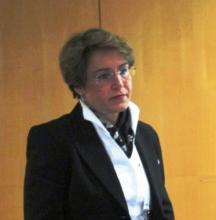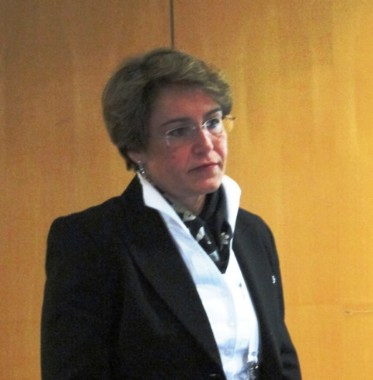User login
MADRID – Results from a small study challenge the long-standing practice of shutting superannuated patients out of phase III trials.
Patients aged 75 years and older are common in everyday clinical practice and comprised almost 10% (8.6%) of 382 nonsquamous non–small cell lung cancer patients who were candidates for bevacizumab (Avastin) between 2001 and 2012, Dr. Andriani Charpidou said in a late-breaking session at the world congress of the American College of Chest Physicians.
Among these 33 patients, 19 had stable cardiovascular disease, 10 had other comorbidities, and 2 had hemoptysis. All patients were Eastern Cooperative Oncology Group (ECOG) performance status 0 or 1 and received a mean of 5.8 cycles (range, 1-21) of bevacizumab.
In all, 26 patients (78.8%) experienced an adverse event, but no AEs were fatal and only 5 patients (15%) discontinued therapy because of toxicities (3 hemoptysis, 1 hematoma, and 1 neutropenia), said Dr. Charpidou, a chest physician with the oncology unit, University of Athens.
Superannuated patients, however, had a higher probability for bleeding events (40%) than reported in the literature.
"There were no thromboembolic events and no worsening of preexisting stable CVD [cardiovascular disease]," she said.
When the investigators compared patients younger than 80 years with those 80 years and older, there were no significant differences in AEs (19 patients vs. 7 patients; P = .652), AEs greater than grade 3 (7 patients vs. 3 patients; P = .673), or discontinuation due to toxicities (5 patients vs. 3 patients; P = .366).
Partial response occurred in 19% and stable disease in 42%, according to the study (Chest 2014;145(3 Suppl):350B).
Once again, no significant differences were observed between the old and superold with regard to progression-free survival (6 months vs. 4 months; P = .660) or overall survival (6.8 months vs. 7.1 months; P = .557), Dr. Charpidou said.
"Taking in mind the limitation of a small sample size, we suggest that superannuated patients should not be excluded from the use of antiangiogenic factors based only on annual age," she said. "Nevertheless, larger cohort studies are needed."
During an interview, session moderator Dr. Mark J. Rosen, medical director with the American College of Chest Physicians, agreed that larger studies are needed, but added, "Every piece of evidence that says ‘Let’s not exclude people because they’re old,’ will push the ball a little further. I think it’s inevitable. Trials are getting more inclusive rather than less so."
During a discussion of the results, CHEST Congress cochair Dr. Joan Soriano of Hospital Universitari Son Espases, Palma de Mallorca, Spain, said that chronic obstructive pulmonary disease trials are being enriched with superannuated patients following the 2012 validation of the Global Lung Function Initiative spirometric prediction equations in patients aged up to 95 years (Eur. Respir. J. 2012;40:1324-43).
"This has reshuffled the clinical trial inclusion criteria, and now some companies already include patients up to 95," he said in an interview. "There aren’t many patients, but at least it’s not an exclusion criterion.
"The populations are aging, so in theory, all these new drugs for cancer, bronchodilators, or anti-inflammatories will be used in the very elderly. So, I’m sure we will see many more superannuated patients in phase III trials."
Dr. Charpidou reported no financial disclosures.
MADRID – Results from a small study challenge the long-standing practice of shutting superannuated patients out of phase III trials.
Patients aged 75 years and older are common in everyday clinical practice and comprised almost 10% (8.6%) of 382 nonsquamous non–small cell lung cancer patients who were candidates for bevacizumab (Avastin) between 2001 and 2012, Dr. Andriani Charpidou said in a late-breaking session at the world congress of the American College of Chest Physicians.
Among these 33 patients, 19 had stable cardiovascular disease, 10 had other comorbidities, and 2 had hemoptysis. All patients were Eastern Cooperative Oncology Group (ECOG) performance status 0 or 1 and received a mean of 5.8 cycles (range, 1-21) of bevacizumab.
In all, 26 patients (78.8%) experienced an adverse event, but no AEs were fatal and only 5 patients (15%) discontinued therapy because of toxicities (3 hemoptysis, 1 hematoma, and 1 neutropenia), said Dr. Charpidou, a chest physician with the oncology unit, University of Athens.
Superannuated patients, however, had a higher probability for bleeding events (40%) than reported in the literature.
"There were no thromboembolic events and no worsening of preexisting stable CVD [cardiovascular disease]," she said.
When the investigators compared patients younger than 80 years with those 80 years and older, there were no significant differences in AEs (19 patients vs. 7 patients; P = .652), AEs greater than grade 3 (7 patients vs. 3 patients; P = .673), or discontinuation due to toxicities (5 patients vs. 3 patients; P = .366).
Partial response occurred in 19% and stable disease in 42%, according to the study (Chest 2014;145(3 Suppl):350B).
Once again, no significant differences were observed between the old and superold with regard to progression-free survival (6 months vs. 4 months; P = .660) or overall survival (6.8 months vs. 7.1 months; P = .557), Dr. Charpidou said.
"Taking in mind the limitation of a small sample size, we suggest that superannuated patients should not be excluded from the use of antiangiogenic factors based only on annual age," she said. "Nevertheless, larger cohort studies are needed."
During an interview, session moderator Dr. Mark J. Rosen, medical director with the American College of Chest Physicians, agreed that larger studies are needed, but added, "Every piece of evidence that says ‘Let’s not exclude people because they’re old,’ will push the ball a little further. I think it’s inevitable. Trials are getting more inclusive rather than less so."
During a discussion of the results, CHEST Congress cochair Dr. Joan Soriano of Hospital Universitari Son Espases, Palma de Mallorca, Spain, said that chronic obstructive pulmonary disease trials are being enriched with superannuated patients following the 2012 validation of the Global Lung Function Initiative spirometric prediction equations in patients aged up to 95 years (Eur. Respir. J. 2012;40:1324-43).
"This has reshuffled the clinical trial inclusion criteria, and now some companies already include patients up to 95," he said in an interview. "There aren’t many patients, but at least it’s not an exclusion criterion.
"The populations are aging, so in theory, all these new drugs for cancer, bronchodilators, or anti-inflammatories will be used in the very elderly. So, I’m sure we will see many more superannuated patients in phase III trials."
Dr. Charpidou reported no financial disclosures.
MADRID – Results from a small study challenge the long-standing practice of shutting superannuated patients out of phase III trials.
Patients aged 75 years and older are common in everyday clinical practice and comprised almost 10% (8.6%) of 382 nonsquamous non–small cell lung cancer patients who were candidates for bevacizumab (Avastin) between 2001 and 2012, Dr. Andriani Charpidou said in a late-breaking session at the world congress of the American College of Chest Physicians.
Among these 33 patients, 19 had stable cardiovascular disease, 10 had other comorbidities, and 2 had hemoptysis. All patients were Eastern Cooperative Oncology Group (ECOG) performance status 0 or 1 and received a mean of 5.8 cycles (range, 1-21) of bevacizumab.
In all, 26 patients (78.8%) experienced an adverse event, but no AEs were fatal and only 5 patients (15%) discontinued therapy because of toxicities (3 hemoptysis, 1 hematoma, and 1 neutropenia), said Dr. Charpidou, a chest physician with the oncology unit, University of Athens.
Superannuated patients, however, had a higher probability for bleeding events (40%) than reported in the literature.
"There were no thromboembolic events and no worsening of preexisting stable CVD [cardiovascular disease]," she said.
When the investigators compared patients younger than 80 years with those 80 years and older, there were no significant differences in AEs (19 patients vs. 7 patients; P = .652), AEs greater than grade 3 (7 patients vs. 3 patients; P = .673), or discontinuation due to toxicities (5 patients vs. 3 patients; P = .366).
Partial response occurred in 19% and stable disease in 42%, according to the study (Chest 2014;145(3 Suppl):350B).
Once again, no significant differences were observed between the old and superold with regard to progression-free survival (6 months vs. 4 months; P = .660) or overall survival (6.8 months vs. 7.1 months; P = .557), Dr. Charpidou said.
"Taking in mind the limitation of a small sample size, we suggest that superannuated patients should not be excluded from the use of antiangiogenic factors based only on annual age," she said. "Nevertheless, larger cohort studies are needed."
During an interview, session moderator Dr. Mark J. Rosen, medical director with the American College of Chest Physicians, agreed that larger studies are needed, but added, "Every piece of evidence that says ‘Let’s not exclude people because they’re old,’ will push the ball a little further. I think it’s inevitable. Trials are getting more inclusive rather than less so."
During a discussion of the results, CHEST Congress cochair Dr. Joan Soriano of Hospital Universitari Son Espases, Palma de Mallorca, Spain, said that chronic obstructive pulmonary disease trials are being enriched with superannuated patients following the 2012 validation of the Global Lung Function Initiative spirometric prediction equations in patients aged up to 95 years (Eur. Respir. J. 2012;40:1324-43).
"This has reshuffled the clinical trial inclusion criteria, and now some companies already include patients up to 95," he said in an interview. "There aren’t many patients, but at least it’s not an exclusion criterion.
"The populations are aging, so in theory, all these new drugs for cancer, bronchodilators, or anti-inflammatories will be used in the very elderly. So, I’m sure we will see many more superannuated patients in phase III trials."
Dr. Charpidou reported no financial disclosures.
AT CHEST WORLD CONGRESS 2014
Major finding: No adverse events were fatal, and only five patients (15%) discontinued therapy because of toxicities.
Data source: A retrospective study of 33 NSCLC patients, aged 75 years and older.
Disclosures: Dr. Charpidou reported no financial disclosures.

